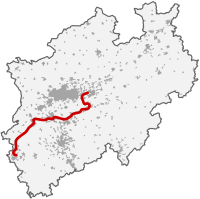Wupper-Express
The Wupper-Express (RE 4) is a Regional-Express service in the German state of North Rhine-Westphalia (NRW) running from Aachen via Mönchengladbach, Düsseldorf, Wuppertal, Hagen to Dortmund. The service is operated every hour by DB Regio NRW. It is the third most widely used Regional-Express line in the area administered by the Verkehrsverbund Rhein-Ruhr with approximately 24,000 passengers a day.[2]
| RE 4 Wupper-Express | |||||||||||||||||||||||||||||||||||||||||||||||||||||||||||||||||||||||||||||||||||||||||||||||||||||||||||||||||||||
|---|---|---|---|---|---|---|---|---|---|---|---|---|---|---|---|---|---|---|---|---|---|---|---|---|---|---|---|---|---|---|---|---|---|---|---|---|---|---|---|---|---|---|---|---|---|---|---|---|---|---|---|---|---|---|---|---|---|---|---|---|---|---|---|---|---|---|---|---|---|---|---|---|---|---|---|---|---|---|---|---|---|---|---|---|---|---|---|---|---|---|---|---|---|---|---|---|---|---|---|---|---|---|---|---|---|---|---|---|---|---|---|---|---|---|---|---|---|
 | |||||||||||||||||||||||||||||||||||||||||||||||||||||||||||||||||||||||||||||||||||||||||||||||||||||||||||||||||||||
| Overview | |||||||||||||||||||||||||||||||||||||||||||||||||||||||||||||||||||||||||||||||||||||||||||||||||||||||||||||||||||||
| Locale | North Rhine-Westphalia, Germany | ||||||||||||||||||||||||||||||||||||||||||||||||||||||||||||||||||||||||||||||||||||||||||||||||||||||||||||||||||||
| Technical | |||||||||||||||||||||||||||||||||||||||||||||||||||||||||||||||||||||||||||||||||||||||||||||||||||||||||||||||||||||
| Line length | 171 km (106 mi) | ||||||||||||||||||||||||||||||||||||||||||||||||||||||||||||||||||||||||||||||||||||||||||||||||||||||||||||||||||||
| Operating speed | 140 km/h (87 mph) (maximum) | ||||||||||||||||||||||||||||||||||||||||||||||||||||||||||||||||||||||||||||||||||||||||||||||||||||||||||||||||||||
| Route number |
| ||||||||||||||||||||||||||||||||||||||||||||||||||||||||||||||||||||||||||||||||||||||||||||||||||||||||||||||||||||
| |||||||||||||||||||||||||||||||||||||||||||||||||||||||||||||||||||||||||||||||||||||||||||||||||||||||||||||||||||||
History
Today's RE 4 is the successor to the former StädteExpress line SE from Aachen to Hagen and Iserlohn. Later, the end point was moved to Hamm and after the abolition of InterRegio services it was extended to Munster. Under the second stage of North Rhine-Westphalia’s integrated timetable (ITF 2), introduced in December 2002, it was replaced by the Maas-Wupper-Express (RE 13) and the Ems-Börde-Bahn (RB 89) services between Hagen and Munster and the Wupper-Express has since then run to Dortmund with a stop in Witten.
Route
The Wupper-Express runs successively over the Aachen–Mönchengladbach, the Mönchengladbach–Düsseldorf and the Düsseldorf–Elberfeld lines. The service then follows the Elberfeld–Dortmund railway as far as Witten station, from where it uses the tracks of the Witten/Dortmund–Oberhausen/Duisburg railway and the Oberstraße Tunnel on its way to Dortmund station. At night, the RE 4 operates to Düsseldorf Airport Terminal station.
The Wupper-Express runs parallel to Rhine-Ruhr S-Bahn lines on large sections of track and it has some of the character of a fast S-Bahn service and is perceived by passengers accordingly.
Rollingstock
The Wupper-Express uses class 111 locomotives and non-air conditioned double-deck coaches. Additional peak hour services operate between Düsseldorf and Aachen with class 110 and 111 locomotives, operated exclusively with refurbished Silberling carriages.
 Wupper-Express near Baal
Wupper-Express near Baal- Preparation of the train in Aachen
 Train running label
Train running label Leaving Aachen Hbf
Leaving Aachen Hbf Wupper-Express on track 3 in Aachen Hbf
Wupper-Express on track 3 in Aachen Hbf
Notes
- Eisenbahnatlas Deutschland (German railway atlas). Schweers + Wall. 2009. ISBN 978-3-89494-139-0.
- "Qualitätsbericht SPNV Im Verkehrsverbund Rhein-Ruhr für 2010" (PDF) (in German). Verkehrsverbund Rhein-Ruhr. February 2011. Retrieved 7 September 2011.
See also
- List of regional rail lines in North Rhine-Westphalia
- List of scheduled railway routes in Germany
External links
| Wikimedia Commons has media related to Wupper-Express. |
- "Wupper-Express". NRW rail archive (in German). André Joost. Retrieved 7 September 2011.